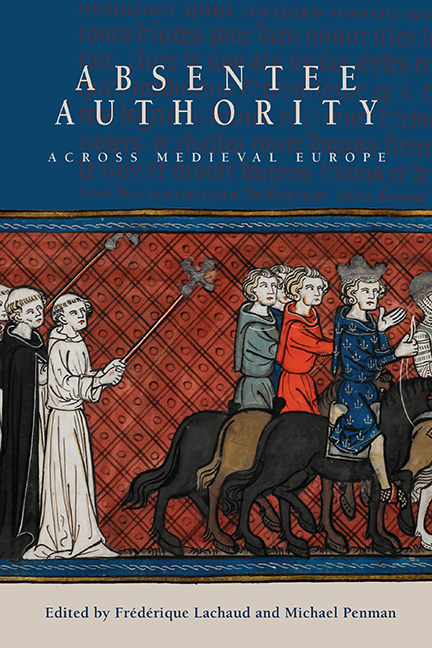Book contents
- Frontmatter
- Contents
- List of Illustrations
- List of Contributors
- Acknowledgements
- List of Abbreviations
- Introduction: Absentee Authority across Medieval Europe
- 1 Incarnating Authority, Exercising Authority: The Figure of the King in the Merovingian Era
- 2 ‘Ubi armae ibi princeps’: Medieval Emblematics as the Real Presence of the Prince
- 3 While the Bishop's Away …: Absentee Bishops of Parma during the Investiture Contest
- 4 An Inconceivable Absence: Usurpers and Illegitimate Rulers in the Genealogical Rolls of the Kings of England, from the Late Thirteenth to the Early Fifteenth Centuries
- 5 Local Loyalty and Absentee Authority in Thirteenth-Century Normandy: The Evidence of the Querimoniae Normannorum (1247)
- 6 Representation and Authority in Thirteenth-Century England and Gascony
- 7 Internal Exiles: Exclusion from the Fourteenth-Century English Court and Kingdom
- 8 ‘Si grant charté a Paris … par defaulté du roy’: Governmental Practice and the Customary Geography of the Absence and Presence of the King in France (1364–1525)
- 9 Was the Couple a Palliative to the Absence of the Prince? The Political Role and Influence of Margaret of Flanders during the Reign of Philip the Bold, Duke and Count of Burgundy (1384–1404)
- 10 Guardian – Lieutenant – Governor: Absentee Monarchy and Proxy Power in Scotland's Long Fourteenth Century
- 11 Absentee Authority in Late Medieval Iceland, as Viewed from the Literary Sources
- 12 Representatives of Kings and ‘Kings’ as Representatives: Authority and its Representation in Professional Groups in Late Medieval and Early Modern France – the Example of the King of Minstrels and of the King of Mercers
- Index
2 - ‘Ubi armae ibi princeps’: Medieval Emblematics as the Real Presence of the Prince
Published online by Cambridge University Press: 16 May 2018
- Frontmatter
- Contents
- List of Illustrations
- List of Contributors
- Acknowledgements
- List of Abbreviations
- Introduction: Absentee Authority across Medieval Europe
- 1 Incarnating Authority, Exercising Authority: The Figure of the King in the Merovingian Era
- 2 ‘Ubi armae ibi princeps’: Medieval Emblematics as the Real Presence of the Prince
- 3 While the Bishop's Away …: Absentee Bishops of Parma during the Investiture Contest
- 4 An Inconceivable Absence: Usurpers and Illegitimate Rulers in the Genealogical Rolls of the Kings of England, from the Late Thirteenth to the Early Fifteenth Centuries
- 5 Local Loyalty and Absentee Authority in Thirteenth-Century Normandy: The Evidence of the Querimoniae Normannorum (1247)
- 6 Representation and Authority in Thirteenth-Century England and Gascony
- 7 Internal Exiles: Exclusion from the Fourteenth-Century English Court and Kingdom
- 8 ‘Si grant charté a Paris … par defaulté du roy’: Governmental Practice and the Customary Geography of the Absence and Presence of the King in France (1364–1525)
- 9 Was the Couple a Palliative to the Absence of the Prince? The Political Role and Influence of Margaret of Flanders during the Reign of Philip the Bold, Duke and Count of Burgundy (1384–1404)
- 10 Guardian – Lieutenant – Governor: Absentee Monarchy and Proxy Power in Scotland's Long Fourteenth Century
- 11 Absentee Authority in Late Medieval Iceland, as Viewed from the Literary Sources
- 12 Representatives of Kings and ‘Kings’ as Representatives: Authority and its Representation in Professional Groups in Late Medieval and Early Modern France – the Example of the King of Minstrels and of the King of Mercers
- Index
Summary
In the Middle Ages kings and princes often found it difficult to exert personal authority over territories that could be very extensive. This led them to act through the mediation of multiple agents; they also resorted to symbolic expressions of their authority. Through these intermediaries the presence of the ruler was made virtually effective, which was perceived as being sufficient. This was because medieval mentalities and sensitivities were familiar with the potential for signa to replace what they expressed. For instance, this was an essential principle in the context of religious and liturgical practices, where images (whether statues or pictorial representations) were seen as expressing divine or saintly presence. In this context also the consecration of the daily Eucharist produced the transubstantiated presence of Christ. On another level, this process led to reifying the presence of those who exerted some political authority: this was achieved through the use of symbolic attributes which they delegated to their representatives, as well as through the use of seals and heraldic emblems.
From an early date, shields of arms were vested with the ability to manifest in absentia the presence of their owners (Plate 1). Heraldic insignia were developed as specific images, and they were increasingly perceived as a kind of double of their bearers. This reality is rarely described as such, yet it is readily perceptible in the manifold practices of medieval heraldry. In the Middle Ages coats of arms meant for display were becoming increasingly popular, and they were seen as an essential element in the exercise of power.
Heraldry, Blazon and Presence in absentia
Heraldic insignia were established during the twelfth century and soon followed defined rules of composition – called ‘blazon’ since the early modern period. These rules stress what is specific about the heraldic image and distinguish it from other types of emblem. They also account for the complexity of what we may term the semiological features of the coat of arms, such as the organization of the various levels of the picture, the way charges are set on the field, colours assembled and so on. The sources for these principles of composition are still shrouded in obscurity.
- Type
- Chapter
- Information
- Absentee Authority across Medieval Europe , pp. 37 - 55Publisher: Boydell & BrewerPrint publication year: 2017



